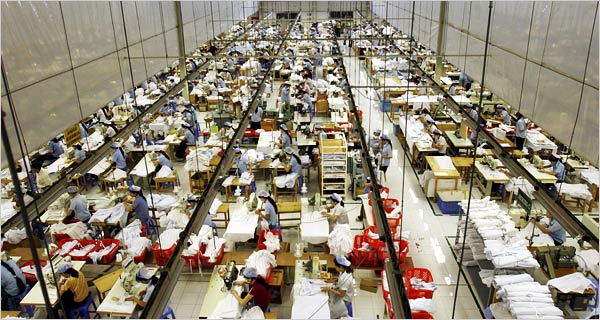The overall increase of world prices aside, the macro turbulence in Vietnam in the fist half of 2008 was essentially home-made. Policy responses were slow and not directed at the factors behind the price hike in 2007. Of particular concern were the large inflows of foreign indirect investment and the extraordinary (and related) high rate of credit growth.
In March 2008, the year-on-year rate of credit growth reached 63 per cent, driven largely by excess liquidity and speculative investment in the stock market and the real estate sector. Massive capital inflows caused upward pressure on the Vietnamese Dong, which threatened to reduce the competitiveness of exports. In response, the State Bank of Vietnam (SBV) bought more than 10 billion U.S. dollars in a single year and consequently injected large amount of cash into the economy.
Vietnam was thus confronted with the ‘impossible trinity’ of simultaneously trying to maintain a virtually fixed exchange rate, an open capital account, and an independent monetary policy. Attempts to sterilize interventions in the foreign exchange market did not succeed and the accumulation of reserves led to an expansion in the monetary base.
A potential adverse impact of high inflation in the presence of stable nominal exchange rate is the loss of competitiveness for the Vietnamese economy against its trading partners. As inflation in Vietnam was much higher than in its main trading partners, there was a significant appreciation the Vietnamese Dong in real terms. There was also the threat of a widening trade deficit, already at 15 per cent of GDP in 2007, and weaker export growth.
High inflation and the resulting instability prompted the government of Vietnam to act and, in March 2008, a stabilization package was launched. The package saw a switch in priority from high growth to stability and included credit tightening, spending cuts and above all, a reduction in the growth target to 7 per cent, much lower than the initial figure set at the end of 2007. Credit growth was to be brought down to 30 per cent in 2008 by a number of measures, notably the sharp increase in the benchmark interest rate, from 8.75 to 12 per cent in May, then 14 per cent in early June. Greater flexibility was also imposed on the exchange rate.
The package also included contractionary fiscal policy measures such as cutting government spending, cancelling inefficient public investment projects and postponing new projects. By May 28, ministries, provinces and the state economic groups had reportedly decided to postpone, delay or stop nearly 1000 projects, equivalent to 7.8 per cent of the total investment budget.
The stabilization package seemingly worked well in dampening the overheated economy. Credit growth was brought under control. The three month moving average of CPI declined rapidly after May and the consumer price index declined after October.
Yet as Vietnam barely struggled out of the home-made turbulence, the world financial crisis caused the broader economic environment to deteriorate dramatically. Like many other open developing economies, Vietnam was inexorably engulfed by the crisis. The adverse effects of the global downturn were visible in the last few months of 2008. Exports declined in 3 consecutive months after September 2008, and only increased slightly in December. Although FDI commitments reached a record of US$ 64 billion, three times those of 2007, FDI disbursement has slowed in recent months. Perhaps the most visible effect has been seen in manufacturing employment. Reports from a sample of 461 firms in Ho Chi Minh City showed that more than 20 per cent of the workers of these firms have already lost their jobs. Nonetheless, the number of reported strikes increased rapidly in 2008.
Against the backdrop of a global recession, an expansionary package was introduced at the end of 2008. Loosening monetary policy saw interest rates cut to 8.5 per cent over a short period of time. A stimulus package of US$6 billion was proposed that includes substantial tax reductions and investment in infrastructure. Important social protection measures, including introduction of unemployment benefits and a 50 per cent increase in the poverty line, were part of the package. The consensus, however, was that appropriate intervention should have economic stability as the first priority. Inflation remained high at 23 per cent in 2008, and the stimulus package should avoid causing another wave of price surges.
Overall, Vietnam performed relatively well in 2008. GDP grew at 6.23 per cent and registered FDI reached a record high. Exports grew much better than those of neighbouring countries, at nearly 30 per cent, even though the increase in world prices played an important role in this achievement.
This year will be more challenging for Vietnam.
The crisis in 2008 revealed serious structural weaknesses in the economy. Vietnam is an economy in which growth is still highly dependent on external demand and external financing. With high levels of current budget deficits, trade deficit and inflation, and decreasing oil revenues, the room for manoeuvring aggregate demand is likely to be limited. The hotly debated stimulus package barely touches upon these structural weaknesses, and is likely to foster inefficiency and waste public resources if not properly designed and implemented. Above all, the delayed and ad-hoc responses to overheating and price overshooting, and conflicting stimulus package proposals are all evidence that Vietnam still lacks an effective mechanism for informed and systematic policy-making.
—
Quang Doan is Senior Economist at the World Bank and was formerly Senior Research Fellow at the Vietnam Academy of Social Sciences, Hanoi.
This is part of the special feature: Reflections on developments in Asia in 2008 and the year ahead

